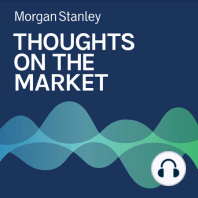3 min listen

U.S. Economy: When to Worry About the Yield Curve
U.S. Economy: When to Worry About the Yield Curve
ratings:
Length:
9 minutes
Released:
Apr 15, 2022
Format:
Podcast episode
Description
While there continues to be a lot of market chatter surrounding recession risks and the U.S. Treasury yield curve, there are several key factors that make the most recent dip into inversion different. Chief Global Economist Seth Carpenter and Head of U.S. Interest Rate Strategy Guneet Dhingra discuss.-----Transcript-----Seth Carpenter: Welcome to Thoughts on the Market. I'm Seth Carpenter, Morgan Stanley's Chief Global Economist, Guneet Dhingra: and I'm Guneet Dhingra, Head of U.S. Interest Rate Strategy. Seth Carpenter: And on this episode of Thoughts on the Market, we're going to be discussing the sometimes inconsistent signals of economic recession and what investors should be watching. It's Thursday, April 14th at 10 a.m. in New York. Seth Carpenter: All right, Guneet, as I think most listeners probably know by now, there's a lot of market chatter about recession risks. However, if you look just at the hard data in the United States, I think it's clear that the U.S. economy right now is actually quite strong. If you look at the last jobs report, we had almost 450,000 new jobs created in the month of March. And between that, the strength of the economy right now and the multi-decade highs in inflation, the Federal Reserve is ready to go, starting to tighten monetary policy by raising short term interest rates and running off its balance sheet. That said, every time short term interest rates start to rise, they rise more than longer term interest rates do, and we get a flattening in the yield curve. The yield curve flattened so much recently that it actually inverted briefly where 2's were higher than 10's in yield. And as we've talked about before on this very podcast, there has been historically a signal from an inverted 2s10s curve to a recession probability, rising and rising and rising. Some of the work you've been doing recently, I think you've argued very eloquently, that this time is different. Can you walk me through why this time is different? Guneet Dhingra: Yeah, absolutely. I mean, right now you cannot have a conversation with investors without discussing yield curve inversion and the associated recession risks. So I think the way I've been framing it, this time is different because of two particular reasons that haven't been always true. The first one is the yield curve today is artificially very distorted by a multitude of factors. The number one and the most obvious one is the massive amounts of central bank bond buying from the Fed, from the ECB, from the Bank of Japan over the last few years. And so that puts a lot of flattening pressure on the curve, which makes it appear that the curve is too flat, whereas in practice it's just the residual effect of how central banks have affected the yield curve. On top of that, what's also happening is the Fed is obviously trying to address the inflation risk and they are looking to make policy restrictive in the next couple of years. So take the dot plot for instance, right, at the March meeting the Fed gave us a dot plot where the median participant expects the Fed funds rate to get to close to 3% in 2023, and the neutral rate that they see for the economy is close to 2.5%. So in essence, the Fed is telegraphing a form of inversion and ultimately the markets are mimicking what the Fed is telling them, which naturally leads to some curve inversion. So overall, I would say a combination of artificially flattening forces, a restrictive fed, just means that 2s10s curve today is not the macro signal it used to be. Seth Carpenter: Got it, got it, so that helps and that squares things, I think, with the way we on the economics team are looking at it. Because in our baseline forecast, there is not a recession in the US. But if that's right, and if we end up avoiding a recession, you've got a bunch of clients, we've got a bunch of clients who are trying to make trades in a market. What are you telling investors that they should be doing, how do you trade in an environment wit
Released:
Apr 15, 2022
Format:
Podcast episode
Titles in the series (100)
Mike Wilson: How Confident Are U.S. Businesses in the Economy? by Thoughts on the Market